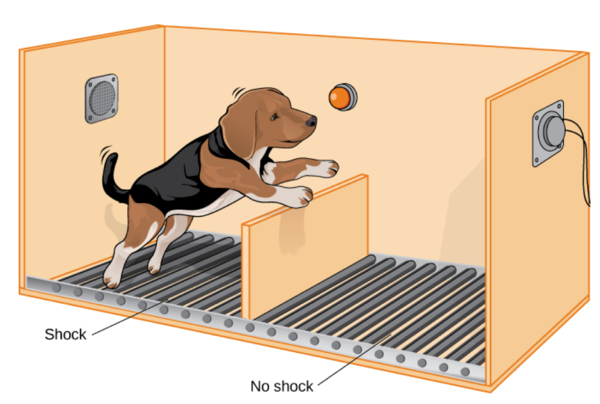EM – Many people know the story about fleas. This creature’s ability to jump is about 18 cm, 200 times its length. But when testing the “glass ceiling effect” to teach the champion that it is having a limited obstacle, it will never try to jump again. It is learned helplessness.
Classic experiments
Two psychologists Martin Seligman and Steven Maier performed the classic experiment in the 1960s.
The dogs will be placed in a box with two chambers separated by a low fence. In it, one room has an electrified floor. When the two researchers placed the dogs in the electrified chamber and turned on the switch, they noticed that some of the dogs weren’t trying to jump over the low fence to the next safe room. Those were the ones that had previously received electric shocks with no way to escape. Those that jump over are usually not subjected to an electric shock beforehand.

Experiment on the phenomenon of learned helplessness in animals
To go further, the researchers assembled a new batch of dogs and divided them into three groups:
Group 1, did not receive an electric shock. Group 2, got an electric shock but was able to escape by pressing the control panel with their nose. Group 3, locked up, is electrocuted and has no way of escaping.
The dogs were then locked in a box. Dogs in groups 1 and 2 quickly learned to jump over small fences so as not to receive an electric shock. Group 3 dogs made no effort to escape the shock. It is because of prior learned experience that they have formed a cognitive expectation that there is nothing they can do to prevent or eliminate electric shocks on them.
The phenomenon of accepting battle without trying to get out is called learned helplessness.
People do another experiment on aquariums. The tank is divided into two by a transparent glass, one side is released a goldfish, the other is the bait. Each time the fish rushed towards the bait, it was hit by the glass, gradually it no longer dared to rush into it. The glass was then removed but an invisible border still became the default barrier and the fish starved to death.
Through research, this phenomenon does not only happen to animals but also to humans. It will be very difficult to change if this negative state is already activated.
This learned helplessness causes many people to lack confidence in their surroundings about their ability to solve problems or strive to achieve success in life. They accept all present difficulties helplessly.
The rule of three times of death
The success stories of companies or scientists are often told heroically and inspire awe. But in reality, life is not so glorious. People have summed up the successes with science, technology, politics, etc., all have gone through a rule of three times of death. Let’s experience the typical stories that demonstrate this.
The generic statin drug that lowers bad cholesterol (LDL), reduces heart attack and stroke in humans before being claimed as one of the greatest medical breakthroughs of the 20th century has passed through death.
Japanese doctor Akira Endo, in the process of researching mushrooms, discovered and extracted a molecule that can destroy cholesterol. ML-236B is the name he gave to this molecule and it is the main ingredient in the drug mevastatin. It wasn’t long before scientists used common sense biology to explain their misconceptions: “Any drug that lowers cholesterol disrupts the normal functioning of the molecule. They are dangerous.” This created a wave of strong opposition and drowned Endo’s idea. That is the first time of death.
Still undeterred, Endo decided to test the ML-236B on live animals. This is a pivotal test. Cholesterol levels did not decrease. He failed again. It is the second time of death.
Endo hasn’t given up yet. The experiment was carried out by him on hens. The results were phenomenal, mevastatin reduced cholesterol by almost half and had no harmful side effects. After that, formal human trials were very positive, reducing cholesterol by up to 30%. But then, another erroneous scientific study was published: Mevastatin in high doses causes cancer in dogs! Immediately, research and development projects for this drug were stopped. Endo had to watch his project fall apart. This is the third time of death.

Without trying to overcome adversity, we will not know how value will be created
Want to pioneer but demand precedent?
Lu Xun has a saying, “ There was never a road, but when many people walk on it, the road comes into existence“. Thus, to have a road, we must be pioneers. Sweet fruit, halo will come, but what will happen if you can’t pass the Three Times of Death.
When interacting with people, they all ask us to break through, to take the lead, but when presenting the plan, they ask “Has anyone done it yet?”. If not, the project is immediately stopped. If we give evidence that countries around the world have done, it is difficult to convince to approve the idea because it is too far away. If we take an example to demonstrate countries in the region, similar to Vietnam, the idea can be accepted conservatively and tentatively.
As the story of “The 10 goes into Resolution 10” of Political Bureau in 1988, it took more than two decades with a lot of skepticism and judgment about the idea of moving away from socialism and privatization of agriculture. In 1965, Secretary of the Provincial Party Committee Kim Ngoc experimented with the form of Household Contracting (later The 10) in Vinh Tuong and Yen Lac districts. This is a form of contracting for each household a certain area of field, cooperative members pay the contracted rate of products according to the area divided to the cooperative, the surplus farmers will take. This is the pioneering, unprecedented direction that has created a launching pad for everyone to have food to eat, so that Vietnam becomes the world’s No. 1 power in terms of rice exports.
Or like Vinfast “recklessly” bringing its electric vehicle products to capture the market in the cradles of the world auto industry such as the US and Germany, which has created a lot of pride and inspiration for Vietnamese people and businessman.
So where will success be if those people are afraid of failure, if infected with learned helplessness syndrome or do not accept failure and then stand up after Three times of death?
Where is the exit?
Human evolutionary history shows that we learn behaviors by interacting and receiving feedback. Therefore, when people try to change the situation but fail many times, people will think that they can’t and no longer want to make the effort.
This can take place in the relationships of individuals to individuals, individuals to corporate organizations, or even more broadly, between businesses and governments.

Early recognition and resolution of internal issues before dominoes fall together create a cumulative effect of learned helplessness
From the perspective of personal relationships, it may be caused by lack of understanding, cooperation methods, large egos, etc., so to some extent it causes learned helplessness in relationships when this goes on for a long time. It leads to inefficient coordination processes, stagnant joint work, and reduced productivity. An accountant who is slow to handle a day’s work has resulted in hundreds of millions of lost businesses due to late contract penalties.
Solving internal conflicts with sincere, frank and resolute efforts from the very beginning will eliminate unnecessary conflicts and eliminate negative domino effects.
From an individual’s point of view to corporate organizations, if learned helplessness occurs, it will form discontent, and oppositional thoughts, going against the direction of the organization. This creates bad influences on corporate culture, and barriers for development.
To solve the problem, individuals should rethink the circle of competence. Those are the skills and knowledge that are within the scope of their job functions. This can be done using the SWOT method (Strengths; Weaknesses; Opportunities and Threats). Then, based on that circle of competence, focus on promoting strengths, bring efficiency in expertise, and contribute to the organization.
From a business perspective to the government, there are businesses that can’t get up after failures. They blame policy, as the lines from macroeconomic planning have created the nails under the red carpet. To some extent, policies still have shortcomings, incomplete parts. But it’s not fair to blame like that. The law of fairness is sometimes not the absolute right and wrong, but knowing how to accept the game and be able to adapt.
Therefore, the mindset of the leader of organizations needs persistence, innovation, and difference. It must become a culture that runs from top to bottom in every business, a part of the motivation for the organization to get up after each fall and commit to new goals and ambitions.
Don’t let the disease of learned helplessness kills us Vietnamese./.
An Tue



